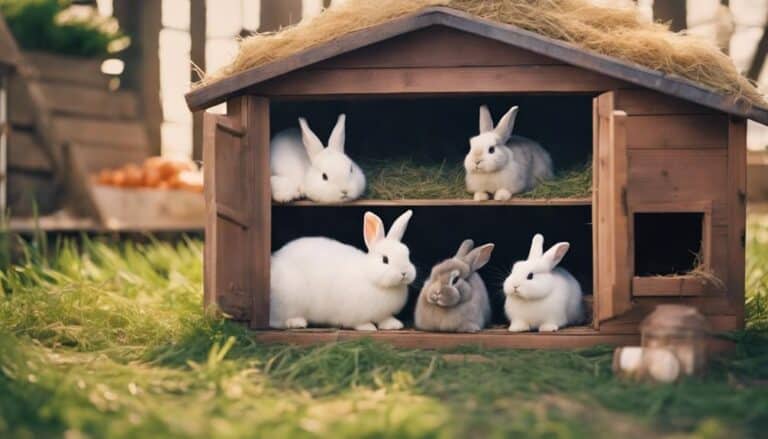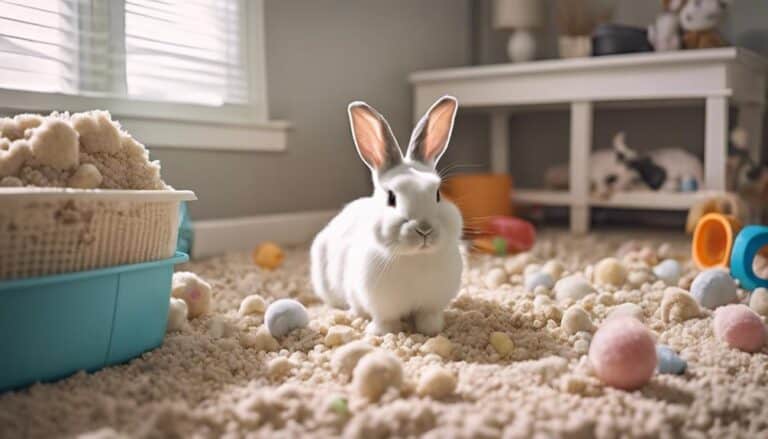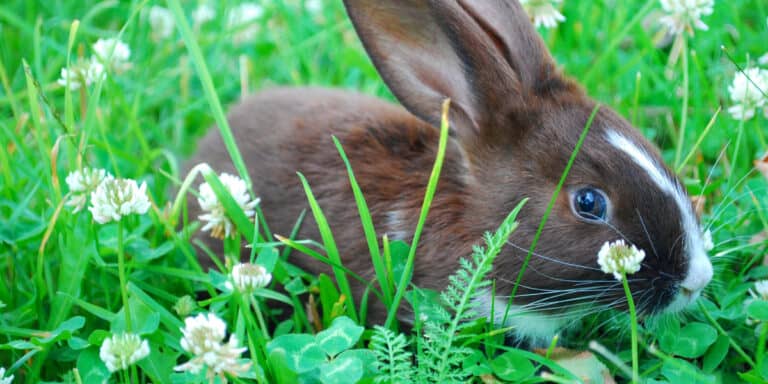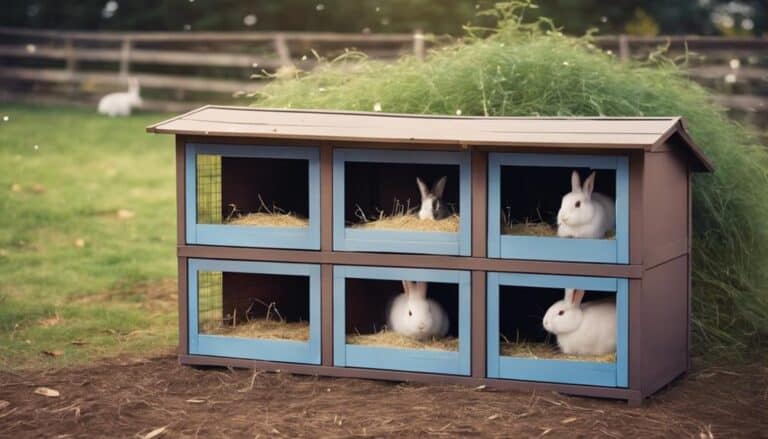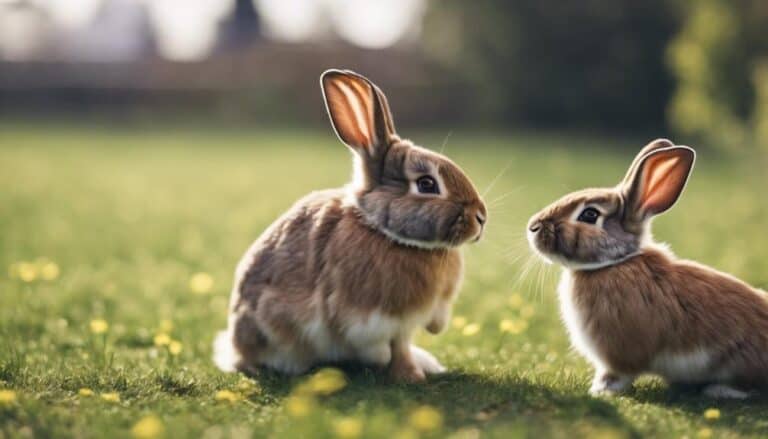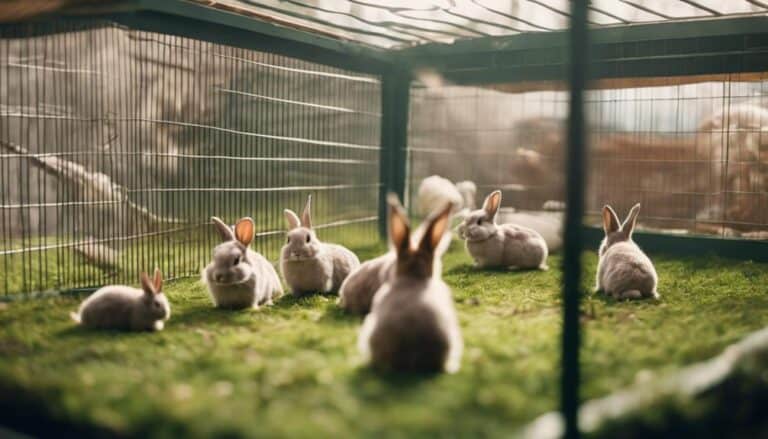As you ponder the complexities of bunny breeding, a stark reality emerges – the intricate web of challenges faced in this seemingly innocent practice. From reproductive maturity obstacles to genetic health concerns, the path of rabbit breeding is laden with hurdles waiting to be discovered.
But why do breeders persist in the face of these challenging truths? What drives them to overlook the potential risks and ethical dilemmas that come with manipulating nature's course?
Join us as we explore deeper into the world of bunny breeding, where the hare-raising truths are waiting to be revealed.
Contents
Key Takeaways
- Timely spaying prevents health risks from early breeding.
- Align breeding with natural seasons for optimal success.
- Responsible breeding practices ensure genetic health and diversity.
- Avoid inbreeding to reduce genetic defects and maintain rabbit populations.
Reproductive Maturity Challenges
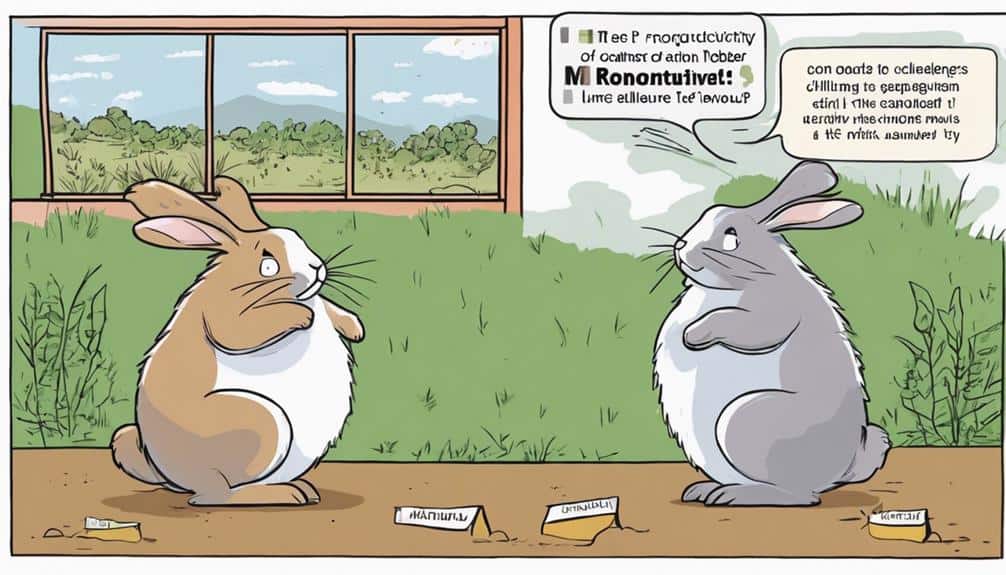
Addressing the challenges of reproductive maturity in bunny breeding requires timely action to prevent unintended consequences. Domestic rabbits can reach sexual maturity as early as 3-5 months old, making early breeding a common issue. When young rabbits breed too soon, they're at risk of experiencing health complications and stress. Female rabbits, in particular, face the possibility of becoming pregnant immediately after giving birth, leading to continuous breeding cycles that can strain their bodies.
To prevent unplanned litters and overpopulation, it's important to avoid delaying the spaying or neutering of rabbits. Proper management of rabbit populations involves understanding and managing their reproductive maturity challenges through timely interventions. By taking proactive steps such as spaying and neutering at the appropriate age, you can help ensure the well-being of domestic rabbits and prevent the negative consequences associated with early breeding practices.
Seasonal Breeding Patterns
Seasonal breeding patterns in rabbits are influenced by various environmental factors such as daylight length, temperature, and food availability. Understanding these patterns is important for successful breeding. The breeding season for rabbits typically peaks in the spring and summer months when days are longer, temperatures are warmer, and food is more abundant. During this time, female rabbits are more likely to ovulate and conceive.
As fall and winter approach, rabbits may experience a decrease in breeding activity. The shorter daylight hours and colder temperatures can signal to female rabbits that it may not be the ideal time to reproduce. This natural response to environmental changes helps safeguard the survival of offspring by avoiding birthing during harsh conditions.
Breeders can use this knowledge to plan breeding schedules more effectively. By aligning breeding efforts with the natural breeding season, they can increase the chances of successful matings and healthier offspring. Monitoring environmental cues and being attuned to the seasonal breeding patterns of rabbits can lead to a more sustainable and productive breeding program.
Genetic Health Concerns

When breeding rabbits, it's important to be aware of potential genetic health concerns that can arise. Interbreeding can lead to issues like dental problems, musculoskeletal disorders, and compromised immune systems in rabbits.
Poor breeding practices can result in respiratory problems, heart conditions, and digestive disorders, impacting the overall well-being of the animals.
Inherited Diseases in Bunnies
In bunny breeding, understanding the prevalence of inherited diseases is essential for ensuring the long-term health and well-being of the rabbits involved. Genetic health concerns can manifest as dental issues, respiratory problems, and gastrointestinal disorders in bunnies. Certain breeds are predisposed to specific genetic health issues; for example, dwarf breeds may be more susceptible to dental problems.
Breeding practices play a critical role in exacerbating these concerns, potentially leading to chronic conditions that affect the rabbits' quality of life. It's important to be aware of inherited diseases in bunnies to engage in responsible breeding practices and proactive healthcare management. By staying informed and taking preventative measures, you can help promote the overall well-being of your bunny companions.
Breeding for Health
Understanding the genetic health concerns associated with breeding practices in rabbits is paramount for maintaining the overall well-being and quality of life of these animals. When breeding for health, consider the following:
- Genetic Diversity: Assure breeding pairs come from diverse genetic backgrounds to minimize the risk of hereditary diseases and deformities.
- Genetic Testing: Prioritize genetic testing and screening to identify and prevent health issues that could be passed on to offspring.
- Avoid Inbreeding: Steer clear of inbreeding practices to prevent the amplification of genetic defects and reduce the likelihood of health complications in rabbit populations.
Inbreeding Risks
Inbreeding risks in bunny breeding can lead to serious genetic health concerns, including dental problems, skeletal deformities, and weakened immune systems. Continuous inbreeding increases the chances of hereditary diseases and abnormalities in offspring, while also reducing genetic diversity and making rabbits more vulnerable to illnesses and reproductive issues.
It's important to prioritize responsible breeding practices that avoid inbreeding to make sure the overall health and well-being of future generations of rabbits.
Genetic Health Concerns
To guarantee the genetic health and well-being of rabbit populations, responsible breeding practices must be diligently followed to mitigate the risks associated with inbreeding. Here are three important points to keep in mind:
- Genetic Health Issues: Inbreeding in wild rabbits can lead to weakened immune systems and increased susceptibility to diseases, impacting their overall health.
- Mortality and Lifespan: Lack of genetic diversity due to inbreeding can result in higher mortality rates and shorter lifespans for rabbits, affecting population sustainability.
- Inbreeding Depression: This can lead to physical deformities, behavioral problems, and reduced fertility in rabbit populations, highlighting the importance of genetic diversity in breeding practices.
Reduced Fertility Rates
Breeding closely related rabbits can result in decreased fertility rates and an increased likelihood of genetic abnormalities. Inbreeding can lead to genetic defects and inbreeding depression, causing smaller litter sizes and higher infant mortality rates in rabbits.
To maintain healthy rabbit populations, genetic diversity is critical. Responsible breeding practices focus on preventing inbreeding to promote overall rabbit welfare. By avoiding breeding closely related rabbits, you can help minimize the risks associated with reduced fertility rates and genetic abnormalities.
Ensuring that rabbits have a diverse genetic background is essential for their well-being and the long-term sustainability of rabbit breeding programs. Remember, prioritizing genetic health in breeding practices is key to producing healthy and thriving rabbit offspring.
Pregnancy Complications
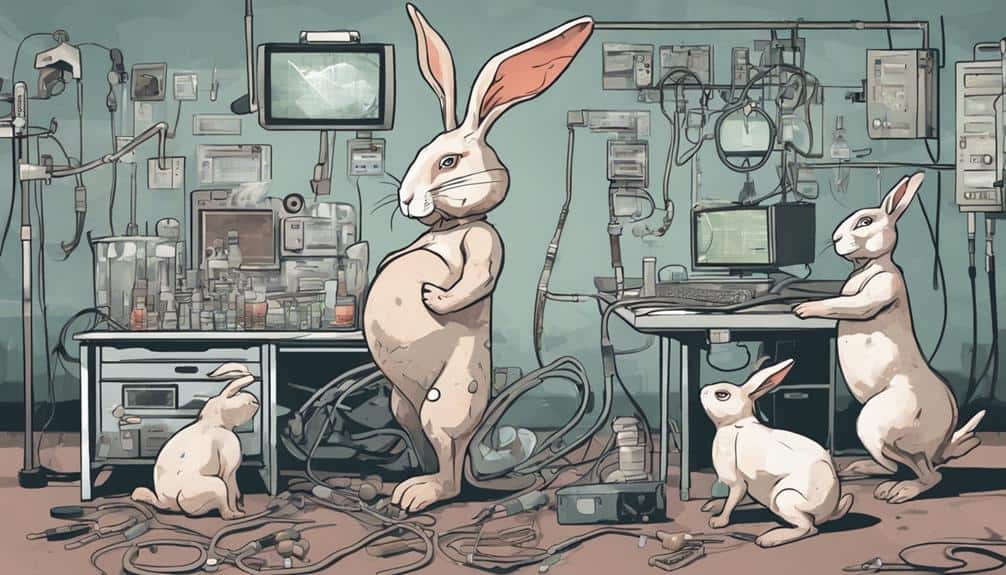
Pregnancy complications in female rabbits can pose serious risks to both the mother and offspring, requiring prompt veterinary attention to guarantee their well-being. When breeding rabbits, being aware of potential issues during pregnancy is essential to guarantee a successful outcome. Here are three key points to bear in mind:
- Dystocia Risks: Female rabbits may encounter dystocia, a condition where they struggle to give birth naturally. This can be life-threatening for both the mother and her babies if not addressed promptly by a veterinarian.
- False Pregnancy Signs: Some pregnant rabbits may experience false pregnancies, exhibiting nesting behaviors and even aggression. These false signs can be confusing but shouldn't be ignored, as they may indicate underlying health concerns.
- Professional Monitoring: It's essential to monitor pregnant rabbits closely for any signs of pregnancy complications. Seeking professional veterinary assistance at the first sign of trouble can help guarantee the health and safety of both the mother and her offspring.
Nesting and Birthing Issues
Female rabbits instinctively prepare nests using hay or fur before giving birth to their kits, ensuring a safe and warm environment for their newborns. This nesting behavior is important for the mother rabbit to provide a secure space for her babies' arrival. However, birthing complications can arise if the nest is inadequate or disturbed during the process. It's important to respect the mother rabbit's space and not interfere with the nest once it's built.
In the event of birthing complications, such as a kit getting stuck during delivery, it's essential to seek veterinary assistance promptly. Mother rabbits are typically very protective of their newborn kits and will nurse them in the nest. Therefore, maintaining a peaceful and stress-free environment for the mother rabbit during nesting and birthing is crucial for the health and well-being of the babies.
Neonatal Care Difficulties
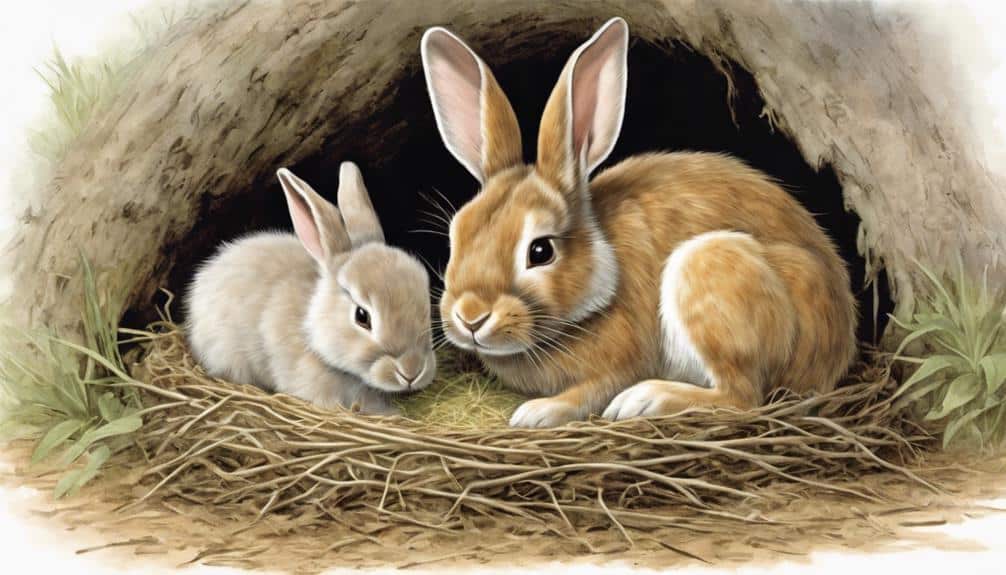
During the neonatal stage, caring for baby rabbits poses significant challenges due to their delicate nature and susceptibility to health issues. Here are three essential aspects to contemplate when providing neonatal care for baby bunnies:
- Vital and Clean Environment:
Baby rabbits need a warm and clean environment to thrive. Make sure they're kept in a draft-free area with appropriate bedding to maintain cleanliness and warmth.
- Essential Nutrition:
Feeding baby rabbits a suitable milk replacement formula is pivotal for their growth and development. Consult a veterinarian or experienced breeder to determine the right formula and feeding schedule.
- Monitoring and Care:
Neonatal rabbits are born hairless, blind, and deaf, relying entirely on their caregiver for survival. Regularly monitor their weight gain, hydration levels, and cleanliness to guarantee their well-being during this critical stage of development. Be attentive to any signs of illness or distress and seek veterinary assistance promptly if needed.
Breeding Ethics and Responsibility
When considering Bunny Breeding, prioritizing ethical practices and responsible care for the rabbits is fundamental to ensuring their well-being and welfare. Breeding ethics revolve around safeguarding the health and overall quality of life for the rabbits involved. Responsible breeding practices entail placing the welfare of the rabbits above financial gain or specific physical attributes. Ethical breeders actively work to curb overpopulation and minimize the instances of abandoned rabbits by breeding thoughtfully and selectively.
Part of breeding responsibly involves providing proper care, ensuring adequate socialization, and considering genetic factors to prevent hereditary health issues. Responsible breeders also advocate for spaying and neutering as a means to manage the rabbit population effectively and reduce the risks of certain health complications associated with breeding.
Frequently Asked Questions
What Is a Fact About Rabbit Breeding?
When breeding rabbits, it's important to understand their genetic selection and reproduction cycle. Careful planning is necessary to prevent overpopulation and health issues. Remember, knowledge is key when it comes to responsibly managing rabbit breeding practices.
Is It Ethical to Breed Rabbits?
Breeding rabbits ethically involves prioritizing responsibility for animal welfare. Understanding the ethical implications of breeding guarantees the well-being of rabbits. By focusing on responsible practices, you can contribute to preventing overpopulation and promoting healthy breeding standards.
How Do You Know if a Rabbit Breeding Was Successful?
To confirm a successful rabbit breeding, observe pregnancy signs like nesting and increased appetite. Veterinarian confirmation through ultrasound or palpation is essential. A gestation period of 28-31 days and physical changes like weight gain indicate breeding success.
Can a Rabbit Breed With a Hare?
You can't breed a rabbit with a hare due to their genetic differences. Rabbits have 22 pairs of chromosomes, while hares have 23 pairs, making successful interbreeding impossible. Conservation efforts aim to protect their unique traits.
Conclusion
As you reflect on the intricate web of challenges that come with bunny breeding, envision the fragile lives at stake. Picture the vulnerability of newborn rabbits struggling to survive without proper care.
Let this image fuel your commitment to responsible ownership and compassionate breeding practices. The future of these delicate creatures rests in our hands – let's choose wisely and protect them from the harsh realities of overpopulation.

